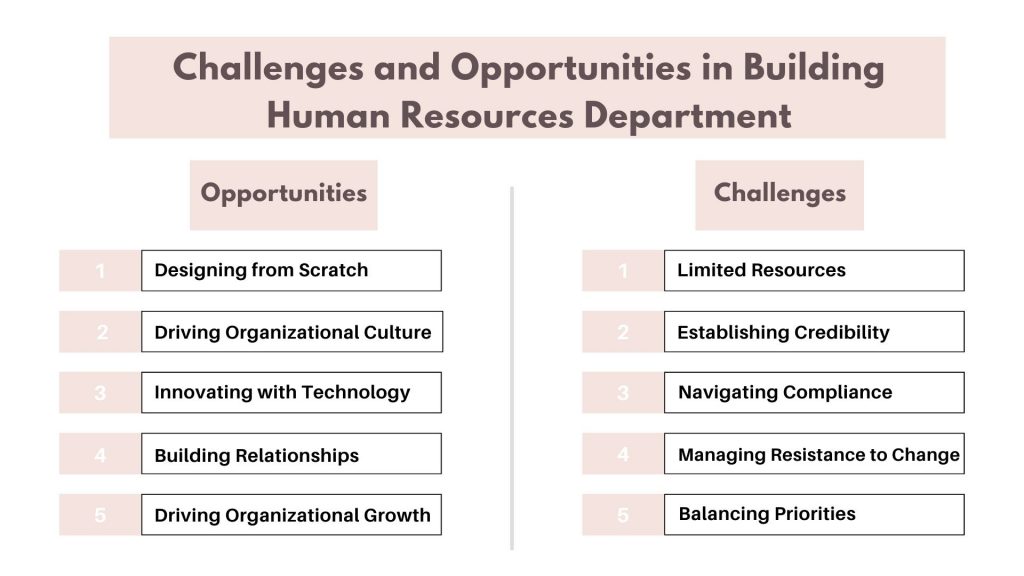Building Human Resources: The Ultimate Guide for First-Time HR Professionals
Welcome to the beginning of an incredible journey! As you step into the role of building human resources department in your company, you’re not just shaping policies and processes – you’re laying the foundation for a thriving workplace culture. Whether you’re the pioneer HR hire or the visionary founder, this guide is your trusted companion every step of the way. Imagine you’re setting the stage for a team where people feel valued, supported, and empowered to excel. That’s the power of a building human resources department. It’s not just about ticking boxes; it’s about creating an environment where employees thrive, compliance is seamless, and the business grows sustainably. This blog will walk you through the essentials of building human resources, helping you navigate challenges, and seize opportunities.Understanding the Role of HR in an Organization
Unlocking the essence of HR within an organization is akin to discovering the heartbeat of its success. Let’s delve into the pivotal role HR plays in driving organizational excellence.Vital Functions and Responsibilities of HR
- Recruitment and Talent Acquisition
- Employee Onboarding and Integration
- Performance Management and Development
- Employee Relations and Conflict Resolution
- Compliance and Legal Matters
- Benefits Administration and Employee Well-being
HR’s Impact on Organizational Success
HR is the cornerstone of organizational success, driving initiatives directly impacting performance, culture, and employee engagement.- Strategic Workforce Planning: HR plays a pivotal role in aligning the workforce with organizational goals through strategic planning. By understanding the company’s needs and anticipating future challenges, HR ensures that the right talent is in place to drive success.
- Talent Development and Retention: HR’s focus on employee development enhances individual skills and contributes to long-term organizational success. By fostering a culture of continuous learning and providing growth opportunities, HR helps retain valuable talent.
- Employee Engagement and Productivity: HR initiatives that foster a positive work environment and employee engagement directly impact organizational success. Engaged employees are more likely to be productive, innovative, and committed to achieving the company’s objectives.
- Effective Performance Management: HR’s involvement in performance management ensures that employees are aligned with organizational goals. HR contributes to improved individual and overall organizational performance through regular feedback, goal setting, and performance assessments.
- Navigating Organizational Change: During times of change, HR plays a crucial role in managing transitions smoothly. Whether it’s organizational restructuring, mergers, or new initiatives, HR helps employees adapt, ensuring minimal disruption and a focus on continued success.
- Cultivating a Positive Organizational Culture: HR shapes and reinforces the organizational culture, significantly influencing how employees work together and contribute to success. A positive culture fosters collaboration, innovation, and a sense of belonging, all essential for achieving organizational goals.

8 Steps to Building Human Resources Department
Step 1: Assess Your HR Needs
Before establishing and building human resources department, assessing your organization’s specific requirements is essential. Here’s how:- Company Size and Stage: Determine if you’re a startup, growing company, or established organization, as each stage has distinct HR needs. Example: Startups may prioritize recruiting top talent and fostering a dynamic culture, while established organizations focus on talent retention and compliance.
- Industry and Workforce: Understand the regulations and dynamics of your industry as they influence HR practices. Example: Healthcare industries may require stringent compliance with healthcare regulations, while tech companies prioritize attracting and retaining tech-savvy talent.
- Budget and Resources: Consider your financial constraints and available resources when planning your HR department. Example: Startups may have limited budgets, prompting a phased approach to hiring HR professionals or investing in cost-effective HR technology solutions.
Step 2: Define Your HR Vision and Mission
Now that you’ve assessed your HR needs, it’s time to articulate your vision and mission for the building human resources department. Defining a clear vision and mission for building human resources department serves as a guiding beacon for your team and aligns their efforts with the organization’s broader goals. Establishing specific goals and crafting a compelling mission statement provides clarity and direction, fostering a sense of purpose and motivation among HR professionals. Here’s how to proceed:- Identify Your HR Goals: Consider what you want your HR department to achieve. Is it attracting top talent, fostering a culture of innovation, or boosting employee engagement and retention? Example: If your company aims to become an employer of choice in the tech industry, your HR goals include attracting and retaining top tech talent, promoting diversity and inclusion, and fostering a culture of continuous learning and development.
- Craft a Clear Mission Statement: Translate your vision into a brief and inspiring mission statement that encapsulates the purpose and values of your HR department. Example: “Our mission is to attract, develop, and retain exceptional talent who embody our company’s values of innovation, collaboration, and excellence. We strive to create an inclusive and engaging workplace culture through strategic HR initiatives where every employee can thrive and contribute to our collective success.”
Step 3: Wear Your Strategy Hat
Aligning your HR strategy with the broader business goals ensures that HR initiatives are purposeful and impactful and contribute directly to the company’s success. By understanding the company’s priorities, you can tailor your HR initiatives to address specific challenges and capitalize on opportunities that align with the company’s strategic direction. This strategic alignment also enhances the credibility and perceived value of the HR function within the organization, positioning HR as a strategic partner in driving organizational growth and success. Here’s how to approach this crucial step:- Align with Company Priorities: Gain a deep understanding of the company’s strategic objectives and priorities. What are the critical areas of focus for growth and development? Example: If the company’s priority is to expand into new markets, your HR strategy might emphasize talent acquisition strategies tailored to those specific markets and cultural contexts.
- Identify Key HR Initiatives: Based on the company’s priorities, identify key HR initiatives that will support and drive those goals forward. Example: If one of the company’s goals is to enhance employee productivity and engagement, your HR initiatives might include revamping performance management processes, implementing employee recognition programs, and fostering a culture of continuous feedback and development.
Step 4: Build Your Core HR Functions
Now that you’ve aligned your HR strategy with the company’s goals, it’s time to establish the core functions of building human resources department. Building robust core HR functions is essential for laying the groundwork for a successful HR department. By establishing effective processes and systems for recruitment, performance management, and compliance, you create a solid foundation that supports the organization’s talent management objectives and mitigates risks associated with legal and regulatory compliance. Here’s how to build the foundational pillars:- Recruitment & Onboarding: Develop robust processes for sourcing, screening, and selecting candidates that align with the company’s culture and values. Design an onboarding program that introduces new hires to the company culture, policies, and expectations, ensuring a smooth transition into their roles. Example: Implement a structured interview process with behavioral and situational questions to assess candidates’ fit for the role and organization.
- Compensation & Benefits: Design competitive compensation packages and employee benefit programs that attract and retain top talent. Example: Conduct market research to benchmark salary ranges and benefits offered by competitors in your industry, ensuring your compensation packages remain competitive and attractive to prospective employees.
- Performance Management: Establish a performance management system that includes goal setting, regular performance evaluations, and feedback mechanisms. Example: Implement a performance review process that encourages ongoing dialogue between managers and employees, focusing on strengths and development areas.
- Compliance & Risk Management: Stay informed about relevant labor laws, regulations, and industry standards to ensure compliance and mitigate risks. Example: Conduct regular audits of HR policies and practices to identify potential non-compliance areas and take proactive steps to address them.
Other Interesting Reads
Step 5: Choose Your Tech Allies
Incorporating HR technology into your department can revolutionize how you manage human capital and administrative tasks. You can streamline processes, improve data management, and enhance organizational communication by leveraging user-friendly tools and software solutions. Choosing the right tech allies empowers your HR team to focus on strategic initiatives and drive organizational success. Here’s how to navigate the selection process:- Consider Implementing HR Software: Explore HR software solutions that automate administrative tasks, manage employee data, and facilitate communication. Example: Invest in an Applicant Tracking System (ATS) to streamline recruitment by tracking candidate applications, scheduling interviews, and managing hiring workflows efficiently.
- Research and Choose User-Friendly Tools: Prioritize user-friendly tools that are easy to implement and intuitive to use, minimizing the learning curve for your HR team. Example: Choose an Employee Self-Service (ESS) portal that allows employees to access their payroll information, request time off, and update personal details seamlessly, reducing the administrative burden on HR staff.
Step 6: Hire Your Dream Team
As you are building human resources department, consider both the immediate requirements of your organization and its long-term vision. Whether hiring a single HR professional to start or gradually expand your team, prioritize individuals who bring expertise to the table and share your enthusiasm for fostering a positive workplace culture and driving organizational success. Building human resources department is an exciting opportunity to assemble a team that aligns with your company’s culture and goals. Here’s how to proceed:- Gradually Build Your HR Department: Identify essential roles based on your company’s priorities and immediate needs. Consider roles such as HR generalist, recruiter, or HR coordinator. Example: If your priority is talent acquisition, prioritize hiring a skilled recruiter who can lead recruitment efforts, build candidate pipelines, and ensure a positive candidate experience.
- Prioritize Individuals Who Share Your Vision: Look for candidates who possess the necessary skills and experience and resonate with your company’s mission and values. Example: Seek HR professionals who are passionate about employee development if your organization prioritizes a culture of continuous learning and growth.
Step 7: Foster a Collaborative Culture
Collaboration lies at the heart of an effective building human resources department. By building solid relationships with other departments, HR can gain valuable insights into organizational needs and priorities, facilitating the development of tailored HR strategies and initiatives. Creating a collaborative environment within your HR department and the organization is essential for driving success and building strong relationships. Here’s how to foster collaboration:- Build Strong Relationships with Other Departments: Take the time to understand the needs, challenges, and goals of other departments within your organization. Example: Collaborate with the marketing team to align employer branding efforts with recruitment strategies, ensuring consistency and effectiveness in attracting top talent.
- Communicate Openly and Transparently with Employees: Foster a culture of open communication where employees feel comfortable sharing feedback, concerns, and ideas. Example: Implement regular town hall meetings, employee surveys, or feedback channels to gather insights and ensure transparency in decision-making processes.
Step 8: Continuous Learning and Improvement
Continuous learning and improvement are fundamental principles that drive the evolution of building human resources departments. By staying informed about industry trends and legal changes, HR professionals can adapt their strategies to meet evolving needs and maintain compliance. Here’s how to foster ongoing growth:- Stay Updated on HR Trends and Best Practices: Dedicate time to research and stay informed about emerging trends, innovative HR practices, and labor laws and regulations changes. Example: Attend industry conferences, webinars, and workshops to gain insights into the latest HR technologies and strategies.
- Regularly Evaluate HR Programs and Initiatives: Assess the effectiveness of your HR programs, policies, and processes through regular reviews and performance metrics analysis. Example: Conduct annual reviews of your recruitment process to identify areas for improvement, such as reducing time-to-hire or enhancing candidate experience.
- Seek Feedback from Employees and Leadership: Encourage open dialogue and feedback loops with employees and organizational leadership to identify areas of strength and opportunities for enhancement. Example: Implement regular employee satisfaction surveys or focus groups to gather insights into employee experiences and perceptions of HR initiatives.
Conclusion
In wrapping up the journey of building human resources department, let’s reflect on the key steps and considerations that pave the way for success. From assessing your unique needs to strategically aligning with company goals, you’ve laid a robust foundation for effective HR management. As you step into this crucial role, remember that agility and adaptability are your greatest allies. The business landscape is ever-changing, and so are the needs of your organization. Embrace flexibility, stay attuned to the pulse of your workforce, and be ready to evolve and building human resources strategies accordingly.Suprabha, a versatile professional who blends expertise in human resources and psychology, bridges the divide between people management and personal growth with her novel perspectives at Risely. Her experience as a human resource professional has empowered her to visualize practical solutions for frequent managerial challenges that form the pivot of her writings.
Take the next step in enhancing your HR skills! Access our free assessments to evaluate your abilities and uncover areas for growth.
Get detailed insights delivered straight to your inbox in just a few minutes.






